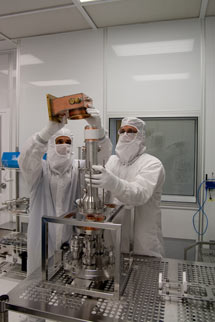
Handy Links
SLAC News Center
SLAC Today
- Subscribe
- Archives: Feb 2006-May 20, 2011
- Archives: May 23, 2011 and later
- Submit Feedback or Story Ideas
- About SLAC Today
SLAC News
Lab News
- Interactions
- Lightsources.org
- ILC NewsLine
- Int'l Science Grid This Week
- Fermilab Today
- Berkeley Lab News
- @brookhaven TODAY
- DOE Pulse
- CERN Courier
- DESY inForm
- US / LHC
SLAC Links
- Emergency
- Safety
- Policy Repository
- Site Entry Form

- Site Maps
- M & O Review
- Computing Status & Calendar
- SLAC Colloquium
- SLACspeak
- SLACspace
- SLAC Logo
- Café Menu
- Flea Market
- Web E-mail
- Marguerite Shuttle
- Discount Commuter Passes
-
Award Reporting Form
- SPIRES
- SciDoc
- Activity Groups
- Library
Stanford
Around the Bay
Recovery Act Funds from Fermilab Boost SLAC Accelerator Tech Development
This month, SLAC National Accelerator Laboratory will receive a major financial boost to help drive the design and fabrication of components for a prototype next-generation accelerator being built at Fermi National Accelerator Laboratory. Fermilab has apportioned $3 million in funding from the American Reinvestment and Recovery Act toward development and delivery of radio frequency power couplers and power distribution technology by the Linac and Radio Frequency Design Group in SLAC's Accelerator Research Division. The work has applications for proposed future accelerator projects.
Couplers are essential for delivering radio frequency power to superconducting accelerator cavities like the ones that are proposed to be used in next-generation accelerators. With support from Particle Physics and Astrophysics Division engineers and technicians, SLAC's Linac and Radio Frequency Design Group started providing Fermilab with couplers last May. Since then, they have delivered two pairs of the devices for Fermilab's small-scale prototype of a superconducting radio frequency accelerator.
The Recovery Act funding will give a big boost to the program. Of $2.5 million in funds for RF power couplers, most will be used to purchase and process the devices. A portion will go to the Klystron Department to drive research and design efforts to bring down the per-unit cost of the devices.
"If the International Linear Collider ever comes about, it's going to take a lot of couplers to build," said Particle Physics and Astrophysics associate Jeff Tice. "So we really want to have a standardized, industrialized component that will be easy and cheap to manufacture."
The funding will allow PPA technicians to process 22 more couplers over the next year. The R&D work will run in parallel, and Tice hopes that the new, lower-cost manufacturing process can be implemented before the work is finished.
"Hopefully the last order that goes out will be the new and improved design," he said.
It's a unique project for SLAC. Instead of using warm accelerator technology—like that used at SLAC's linac, which operates relatively close to room temperature—the new cavities would be cold, running at 2 degrees Celsius above absolute zero to achieve a low-loss superconducting state. In order to keep the accelerator at such low temperatures, it must be housed in a series of large cooling chambers called cryostats. In warm accelerators, waveguides transfer radio frequency waves directly from a klystron to the accelerator itself. In a cold accelerator, the signals must be delivered through the cryostat first, crossing a temperature gradient of about 300 degrees Celsius along the way. The couplers facilitate the transfer, carrying RF power into the accelerator cavity while minimizing the amount of heat introduced to the cryostats.
Getting the couplers ready for Fermilab is a tricky job in itself, though. Because any particulate matter introduced to the accelerator would prevent it from working properly, engineers at SLAC must get the couplers particle-free. So for SLAC, joining the project meant spending two years building a clean room before even starting work on the couplers themselves. And to get the devices particle free, the clean room had to have a class 10 rating—a room so clean that there are no more than 10 particles larger than 0.5 microns within a cubic foot of air.
Once the clean room was finished, the engineers set to work, spending hours at a time working over the components, washing them piece by piece in ultrasonic baths, reassembling them for testing, then taking them apart again to be shipped. Even things like tightening or loosening a bolt too fast can create unwanted detritus, and so have to be done with extreme care and precision.
The current work for Fermilab's prototype accelerator could lead to further coupler collaboration on future projects.
—Nicholas Bock
SLAC Today, October 15, 2009
